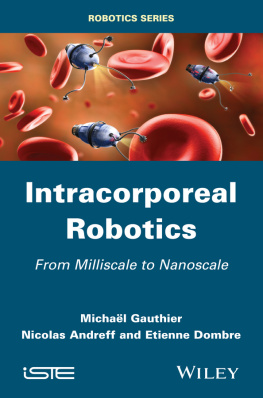Dombre Etienne Gauthier Michael Andreff Nicolas - Nanorobotics
Here you can read online Dombre Etienne Gauthier Michael Andreff Nicolas - Nanorobotics full text of the book (entire story) in english for free. Download pdf and epub, get meaning, cover and reviews about this ebook. year: 2014, publisher: Wiley, genre: Home and family. Description of the work, (preface) as well as reviews are available. Best literature library LitArk.com created for fans of good reading and offers a wide selection of genres:
Romance novel
Science fiction
Adventure
Detective
Science
History
Home and family
Prose
Art
Politics
Computer
Non-fiction
Religion
Business
Children
Humor
Choose a favorite category and find really read worthwhile books. Enjoy immersion in the world of imagination, feel the emotions of the characters or learn something new for yourself, make an fascinating discovery.
- Book:Nanorobotics
- Author:
- Publisher:Wiley
- Genre:
- Year:2014
- Rating:3 / 5
- Favourites:Add to favourites
- Your mark:
- 60
- 1
- 2
- 3
- 4
- 5
Nanorobotics: summary, description and annotation
We offer to read an annotation, description, summary or preface (depends on what the author of the book "Nanorobotics" wrote himself). If you haven't found the necessary information about the book — write in the comments, we will try to find it.
Nanorobotics — read online for free the complete book (whole text) full work
Below is the text of the book, divided by pages. System saving the place of the last page read, allows you to conveniently read the book "Nanorobotics" online for free, without having to search again every time where you left off. Put a bookmark, and you can go to the page where you finished reading at any time.
Font size:
Interval:
Bookmark:


First published 2014 in Great Britain and the United States by ISTE Ltd and John Wiley & Sons, Inc.
Apart from any fair dealing for the purposes of research or private study, or criticism or review, as permitted under the Copyright, Designs and Patents Act 1988, this publication may only be reproduced, stored or transmitted, in any form or by any means, with the prior permission in writing of the publishers, or in the case of reprographic reproduction in accordance with the terms and licenses issued by the CLA. Enquiries concerning reproduction outside these terms should be sent to the publishers at the undermentioned address:
ISTE Ltd
27-37 St Georges Road
London SW19 4EU
UK
www.iste.co.uk
John Wiley & Sons, Inc.
111 River Street
Hoboken, NJ 07030
USA
www.wiley.com
ISTE Ltd 2014
The rights of Michal Gauthier, Nicolas Andreff and Etienne Dombre to be identified as the author of this work have been asserted by them in accordance with the Copyright, Designs and Patents Act 1988.
Library of Congress Control Number: 2013957115
British Library Cataloguing-in-Publication Data
A CIP record for this book is available from the British Library
ISBN 978-1-84821-371-5
Introduction
For almost 30 years, research in medical robotics has led to many prototypes that have been validated technically, and some clinically. There are many specialties in this regard. Orthopedics, neurosurgery, endoscopic microsurgery (mainly gynecology, urology, fetal surgery, etc.), cardiac, thoracic and vascular surgery, ear, nose and throat (ENT) surgery, etc., are a few among others.
It is clear that robotics may facilitate surgical approaches such as minimally invasive surgery (MIS), natural orifice transluminal endoscopic surgery (NOTES), single port access (SPA) surgery and interventional radiology, and it is very promising in microsurgery. We list in some benefits for the patient and the surgeon of robots in the operating room (OR). To summarize, surgical robotics may contribute to less invasive and more accurate surgical gestures. It may also be useful in transcending human limitations.
Considering the benefits, it is surprising that only a few prototypes have managed to find their way into OR or medical offices. Several reasons are generally raised of which a few of the most important are given below:
The cost issue: the cost effectiveness of robotic systems has not yet been proved. Several factors worked against it: the cost of the OR is increased; a technical team is required; the surgical team has to be trained; the setup and skin-to-skin times are longer than conventional procedure. The compatibility with the cluttered environment of the OR should also be improved: the robots are still too bulky; quite often, the weight, dimension and footprint of the robot are out of proportion with respect to the force it has to exert and the workspace it has to cover during an operation.
The clinical added value: as noted in the report of the IARP Workshop on Medical Robotics, the medical added value has to be improved: Medical robotics suffers from a chicken and egg phenomenon in the sense that systems need to be developed before they can be tested clinically, but only through the latter will their true effectiveness and utility be proven [].
Safety issues: a medical robot is a complex system that consists of (1) an articulated and motorized mechanical structure, (2) a humanmachine interface, (3) electronic components and (4) a software controller. These components are used to perform operations in a constrained and not fully structured environment, inside and/or outside of the patients body, in cooperation with the surgeon, and in the presence of the medical staff. Thus, it is easy to understand that a system failure or dysfunction can be extremely critical [SAN 13b].
This analysis pushes for the development of a new generation of robotic systems along three major challenges [DOM 12b]:
Cost: they will be less bulky and less expensive than the current systems.
Ergonomics: they will be of plug and play-type like most tools and equipment in the OR in order to minimize the installation time. They will also be easy to use in order not to require special technical skills of the staff. Moreover, the sensors will be sterilizable, otherwise disposable, and highly integrated into the architecture of these systems.
Safety and medical added value: they will be increasingly less invasive and will not significantly extend the duration of the intervention. Moreover, the doctor/robot interfaces will be specifically designed to facilitate the implementation while ensuring that the level of operational safety is as high as possible.
.Medical robots: benefits for the surgeons and patients
| Fields of application | Potential benefits to the surgeon | Potential benefits to the patient |
| Orthopedic surgery |  Precision PrecisionPossibility of carrying out complex cutting, drilling, milling Integration of multimodal preoperative and intraoperative information (vision, force)  safety (virtual fixture) safety (virtual fixture) | Less revision surgery Expected longer lifetime of prostheses |
| Minimally invasive endoscopic surgery | 3rd hand Greater comfort Elimination of the fulcrum effect Additional internal mobilities Compensation of physiological movements | Toward an increasingly less invasive surgery and without visible scars |
| Neurosurgery Interventional radiology Radiotherapy |  Precision Precision Safety (avoidance of vital structures) Safety (avoidance of vital structures)Compensation of physiological movements  Exposure to radiations Exposure to radiationsPrecise spatial tracking of the dosimetric planning |  Invasiveness InvasivenessEarly treatment of increasingly smaller tumors  Exposure to radiations of healthy tissues Exposure to radiations of healthy tissues |
| Microsurgery | Downscaling of the forces and displacements Surgeons tremor filtering | Development of innovative procedures beyond the accuracy limits of the surgeon |
The above specifications (cost, ergonomics and safety) imply that the future surgical robots should be smaller and dedicated to a limited number of functionalities with a certain level of autonomy appropriate for the complexity of the task they are supposed to achieve. In any case, the surgeon must maintain control of the gesture no matter what, at any time of the operative or exploratory procedure. From this observation, we understand that for many surgical applications, it makes sense to integrate the mobilities and the sensors inside the body rather than outside. In other words, rather than manipulating a multimillennial rigid instrument (like scissors or clamps) with an extracorporeal robot, the idea is to develop intracorporeal robots, offering at least the same performance of movement quality, safety and interaction with the doctor.
Next pageFont size:
Interval:
Bookmark:
Similar books «Nanorobotics»
Look at similar books to Nanorobotics. We have selected literature similar in name and meaning in the hope of providing readers with more options to find new, interesting, not yet read works.
Discussion, reviews of the book Nanorobotics and just readers' own opinions. Leave your comments, write what you think about the work, its meaning or the main characters. Specify what exactly you liked and what you didn't like, and why you think so.










